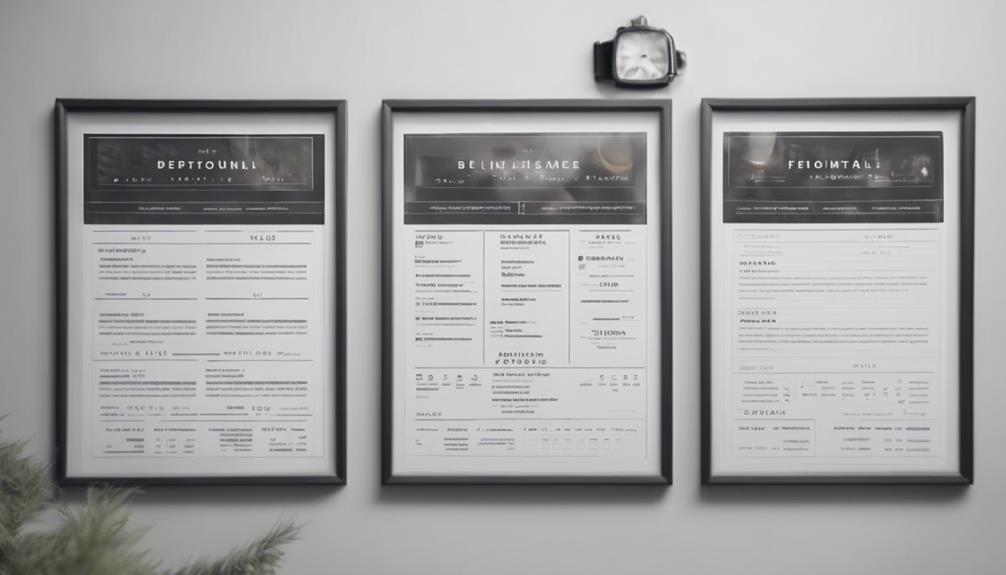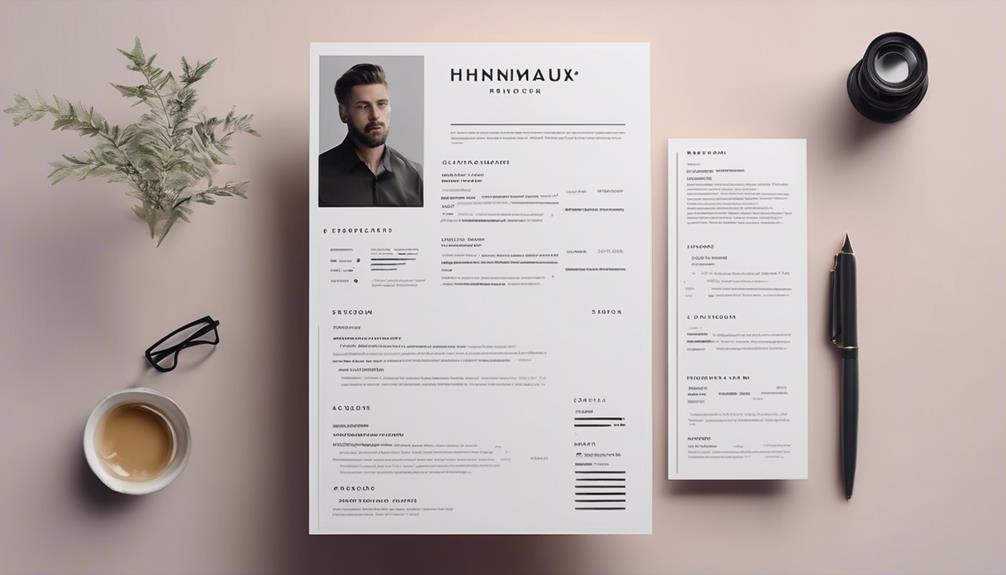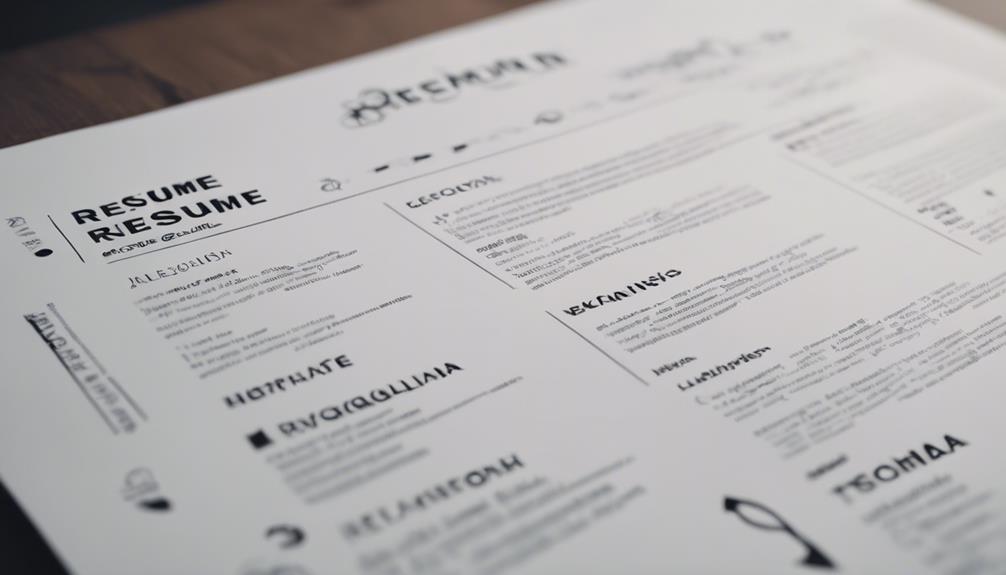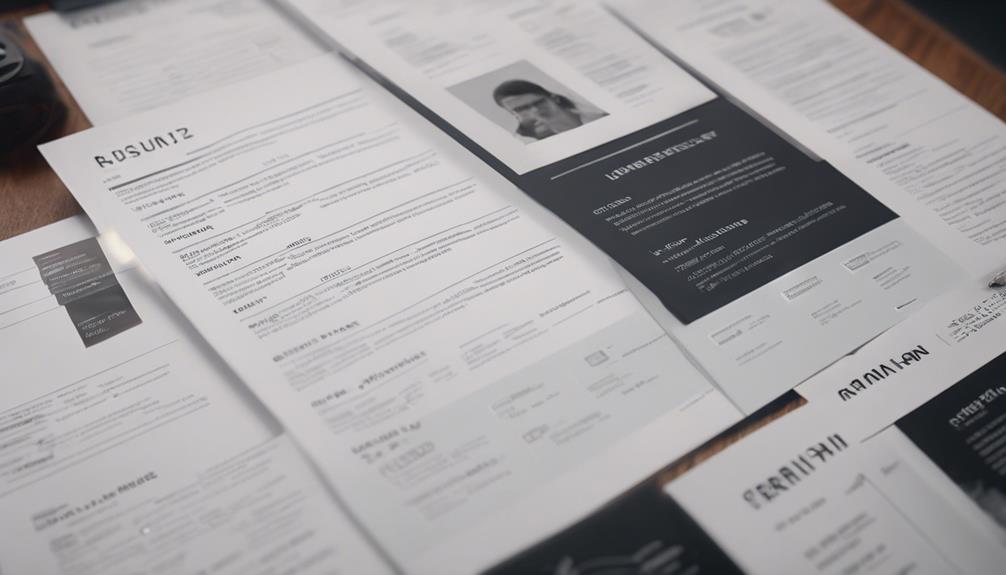Crafting a resume that delivers results involves choosing the right format, tailoring content, and highlighting key skills. Start by considering your work history and career objectives to select a suitable format—chronological, functional, or a blend. Tailor your resume for each job by highlighting relevant skills, aligning with job requirements, and using active language. Create a compelling summary or objective that captures attention and showcases achievements. Emphasize key skills, prioritize relevant experiences, and meticulously proofread your resume for typos or errors. Consider professional assistance to enhance professionalism and stand out to recruiters. Master these steps to craft a winning resume.
Key Takeaways
- Choose the right resume format based on work history and career objectives.
- Tailor your resume to match job requirements and use relevant keywords.
- Craft a compelling summary or objective tailored to the job listing.
- Highlight key skills with quantifiable results to showcase impact.
- Prioritize recent and relevant experiences to catch the employer's attention.
Choosing the Right Resume Format

When selecting the appropriate resume format, consider your work history and career objectives to ensure the best presentation of your qualifications.
The three common resume formats to choose from are the chronological resume, functional resume, and combination resume.
If you have a strong work history with consistent growth and relevant experience, a chronological resume might be the best fit for you. This format showcases your career progression in reverse-sequential order, making it easy for employers to see your professional trajectory.
On the other hand, if you're looking to highlight specific skills and accomplishments rather than a traditional work history, a functional resume could be more suitable. This format focuses on your abilities and achievements, allowing you to tailor your resume to different job requirements.
For those who want to combine the best of both worlds, a combination resume blends the chronological and functional formats. This type of resume highlights both your work history and skills, providing a thorough overview of your qualifications.
Tailoring Your Resume for Each Job

To maximize your chances of standing out to potential employers, tailor your resume for each job by highlighting relevant skills and experiences. Customizing your resume to align with the job description demonstrates that you are a suitable candidate for the role. Researching the company and understanding the job requirements are vital steps in crafting a tailored resume that catches the employer's attention. Utilizing keywords from the job posting not only shows alignment with the employer's needs but also improves your chances of passing through applicant tracking systems.
| Benefits of Tailoring Your Resume |
|---|
| Highlights relevant skills |
| Demonstrates fit with job description |
| Increases chances of passing through applicant tracking systems |
Crafting a Compelling Summary/Objective

When crafting your summary/objective, remember to tailor it to the job listing to highlight your relevant skills and experiences effectively.
Placing this section at the top of your resume can grab the employer's attention and make a strong first impression.
Use active language to showcase your achievements and align your summary/objective with the job requirements to demonstrate your fit for the role.
Summary Vs Objective
Craft a compelling summary or objective that aligns with your career stage and effectively showcases your qualifications to potential employers. For experienced professionals, a summary is the way to go. Summaries should emphasize your quantifiable achievements and relevant skills, providing a snapshot of your career highlights.
On the other hand, objectives are more suitable for entry-level candidates, focusing on outlining career goals and demonstrating motivation to excel in a specific role.
Here are four key points to keep in mind when deciding between a summary and an objective for your resume:
- Experience Level: Assess whether you have substantial work experience or are just starting your career.
- Career Achievements: Evaluate if you have notable accomplishments that can be highlighted in a summary.
- Job Relevance: Ensure that your chosen section aligns with the job requirements and showcases your suitability for the role.
- Tailoring: Customize your summary or objective to match the job listing to capture the employer's attention effectively.
Impactful Content
Assess your relevant accomplishments and career stage to create a summary or objective that effectively showcases your qualifications to potential employers in your resume. Your summary or objective should be a snapshot of your professional identity, highlighting your key strengths and career goals.
Remember, this section is your chance to make a strong first impression in just a few sentences. To craft an impactful summary or objective, align your skills and experiences with the job requirements. Incorporate keywords from the job listing to increase the visibility of your resume to applicant tracking systems.
Keep it concise, typically 2-4 sentences, to guarantee employers can quickly grasp your value proposition. Placing this section at the top of your resume enhances its visibility, setting the stage for the rest of your document.
Tailoring to Job
To captivate potential employers, make sure your resume's summary or objective is tailored precisely to match the job requirements and keywords from the listing. Here's how to craft a compelling summary or objective that aligns with the job you're applying for:
- Highlight Relevant Work Experience:
Focus on showcasing your most relevant work experiences that directly relate to the job listing. Use specific examples that demonstrate your skills and accomplishments in those areas.
- Use Keywords from the Job Listing:
Incorporate keywords and phrases from the job listing into your summary to guarantee that your resume gets noticed by applicant tracking systems and hiring managers.
- Customize Your Summary:
Tailor the language and tone of your summary to match the company culture and values mentioned in the job listing. This shows that you've done your research and are genuinely interested in the position.
- Connect Your Work History to the Job Requirements:
Draw clear connections between your past work history and the job requirements outlined in the listing. Explain how your experiences make you a strong candidate for the position.
Highlighting Key Skills

Emphasize your core competencies when highlighting key skills on your resume to effectively showcase your qualifications to potential employers. In your skills section, make sure to include relevant hard skills like proficiency in specific software or tools to demonstrate your technical abilities. Additionally, highlight soft skills such as communication, problem-solving, and time management to showcase your interpersonal strengths.
When presenting your key skills, use quantifiable results to emphasize the impact of your abilities. For instance, mention achievements like increasing sales by 20% or reducing project timelines by 25% to provide concrete evidence of your capabilities. Remember to tailor your skills section to align with the job requirements by incorporating keywords from the job description. By striking a balance between hard and soft skills, you can present a well-rounded skill set that appeals to potential employers.
| Hard Skills | Soft Skills | Quantifiable Results |
|---|---|---|
| Proficiency in specific software | Communication | Increased sales by 20% |
| Technical skills | Problem-solving | Reduced project timelines by 25% |
| Data analysis | Time management | Improved customer satisfaction by 15% |
| Programming languages | Teamwork | Streamlined processes, saving 30 hours monthly |
Showcasing Professional Experience

Demonstrate your professional expertise by highlighting quantifiable achievements and results in your resume's 'Showcasing Professional Experience' section. When detailing your professional experience, focus on measurable achievements rather than just listing job duties. Use action verbs like 'achieved,' 'implemented,' or 'generated' to showcase your active role in previous roles.
To effectively showcase your professional experience, consider the following tips:
- Quantify Your Accomplishments: Provide specific numbers or percentages to demonstrate the impact of your work. For example, mention how you increased sales by 20% or saved the company $10,000 through process improvements.
- Use Action Verbs: Start bullet points with strong action verbs to convey your proactive involvement in projects. Words like 'implemented,' 'developed,' or 'spearheaded' can make your achievements stand out.
- Tailor Your Content: Align your professional experience section with the job requirements to highlight relevant skills and experiences that match the position you're applying for.
- Prioritize Recent Experiences: Showcase your most recent and relevant work experiences first to catch the employer's attention and demonstrate your career progression effectively.
Proofreading and Finalizing Your Resume

Highlight your attention to detail and professionalism by meticulously proofreading and finalizing your resume before submission. Proofreading is crucial as 76% of resumes get rejected due to typos or grammatical errors. Tailoring your resume for each job application can significantly increase your chances of success, given that 60% of resumes contain sloppiness and errors. Seek feedback from trusted individuals to proofread your resume, as even unprofessional email addresses can lead to a 76% rejection rate. Remember, interviewers spend only 6 seconds scanning a resume, so ensure yours is concise and error-free. Additionally, consider utilizing professional resume writers for assistance in proofreading and consolidating your resume for a polished final version.
| Proofreading | Tailoring | Feedback |
|---|---|---|
| Avoid typos and grammatical errors | Customize for each job | Seek input from trusted sources |
| Ensure clarity and precision | Highlight relevant skills | Consider professional help |
| Make a good first impression | Increase chances of success | Improve overall quality |
| Catch and correct errors | Stand out to recruiters | Enhance professionalism |
Frequently Asked Questions
How Do You Write a Resume That Gets Results?
To write a resume that gets results, tailor it to the job description. Use the STAR method to highlight accomplishments. Focus on relevant skills and achievements, not just job duties. Avoid common mistakes. Seek feedback for a polished resume.
How Do I Make Sure My Resume Gets Picked?
To guarantee your resume gets picked, tailor it to each job application with keywords, quantify achievements with numbers, use a clean layout, and avoid common mistakes. Seek feedback and refine with resources for effectiveness.
How to Write a Resume That Will Get You Hired?
To write a resume that will get you hired, tailor it to the job, highlight quantifiable achievements, use relevant keywords, and craft a compelling summary. Incorporate feedback and professional resources to enhance quality and effectiveness.
How to Add Measurable Results in a Resume?
To add measurable results in your resume, quantify achievements with numbers like 'boosted revenue by 20%' or 'slashed expenses by $15,000.' Use specific metrics such as 'raised client satisfaction by 10 points' to showcase impact and stand out.
Conclusion
To wrap up, remember to:
- Use the right resume format
- Customize it for each job
- Create an engaging summary
- Emphasize key skills
- Showcase your experience
- Proofread for perfection
By following these steps, you can create a resume that gets results.
So, don't delay, start crafting your persuasive curriculum vitae today!









